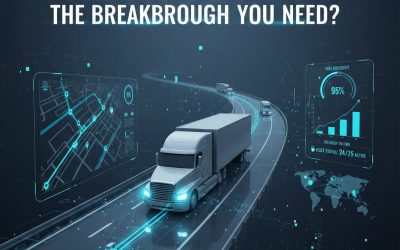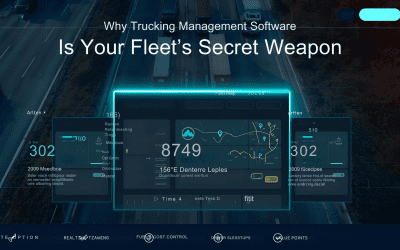Are you considering new trucking management system software (TMS)? Or thinking about using an all-in-one trucking management software solution for the first time?
The last four months of the year are the prime time to start this process, especially if your goal is to be fully operational by January 1. In other words, if you’re reading this in August, start looking for and integrating your software solution now! This will ensure that all your records are in one place (i.e., on the TMS) for the entire upcoming year.
The Importance of Timing
Why this timing, you might ask? Well, choosing and implementing a TMS system involves several crucial steps: initial research, trade study analysis, system selection and signing, data transfer and data entry, company-wide training, and finally, setting the go-live date.
All these steps require time and careful planning. Consider these typical time frames:
- Research and trade study process (including time to trial multiple software platforms to find the best fit for your business): 1+ month
- System selection and signing: up to 2 weeks
- Data transfer and data entry: up to 1 week
- Company training across all areas: up to 1 month
You’ll have to work through all of these steps before you’re ready for that big “go live” date.
While there’s no strict deadline for choosing a TMS, switching systems mid-year can make things very difficult. You’ll be stuck managing an immense data transfer in the middle of the year when you merge everything into your new system, or your company will have to reconcile the data from two systems at the end of the year. This can complicate things like generating 1099 tax reports for each driver.
Reasons to Consider a New TMS Now
You might wonder why your company should even consider getting a TMS, or switching to a different one, at this time. The reasons are numerous:
- Improved efficiency: TMS helps you identify inefficiencies in your current logistics processes, enabling you to optimize them before the start of the new year.
- Enhanced visibility and control: With real-time visibility into transportation operations, you can track shipments, monitor carrier performance, and proactively address issues.
- Scalability and growth: As your business grows, a TMS can handle increased transportation volumes and complexities, paving the way for future growth.
- Cost reduction: By identifying cost-saving opportunities like optimizing routes and reducing fuel consumption, a TMS allows businesses to start saving at the beginning of the new year.
- Competitive advantage: In today’s competitive market, a TMS gives you an edge by improving customer service, optimizing operational efficiency, and offering advanced tracking capabilities.
- Data-driven decision making: The valuable data and analytics generated by a TMS help you make informed decisions to optimize logistics operations and drive business growth.
- Seamless integration: As we’ve established, it can take some time for TMS integration, data migration, and training. By starting now, you ensure a seamless integration process and a trained team ready to use the TMS from the start of the new year.
- Improved customer service: With accurate tracking information, proactive notifications, and faster response times, a TMS enhances your customer service capabilities.
- Better compliance: Regulatory and compliance requirements in the transportation industry are always evolving. By implementing a TMS before January 1, you can ensure your company stays up to date with the latest standards. Imagine letting DOT compliance software manage all of these headaches for you in 2024.
- Operational resilience: A TMS provides a robust and reliable system for managing transportation operations, ensuring smooth operations and mitigating disruptions in the new year.
- Long-term strategic planning: Implementing a TMS is a strategic decision. Starting the process now gives you ample time to evaluate different TMS options, negotiate contracts, and create a roadmap for successful implementation.
What to Look for in a TMS?
With so many platforms available, you might feel overwhelmed. Here are some criteria to consider as you weigh the options:
- All-in-one: If you already have multiple software solutions in place for managing your trucking company, you’re probably wasting money on the different platforms that likely have overlapping capabilities. Look for an all-in-one solution.
- Quick and easy to implement: Is the interface user-friendly and intuitive? For all users–from office staff to drivers? You should also make sure that there is training and ongoing customer support to help you through the implementation process and beyond.
- Works with existing systems: How does the TMS you are considering integrate with existing systems and hardware? Does it leverage your existing infrastructure or force you to waste past investments?
- Customizable to your needs: How customizable is the system? Can you tailor different features and modules to your specific requirements? Or is it a rigid, one-size-fits-all software that you must fit your needs around?
- Scalable for growth: As your business grows, will the TMS accommodate increased transportation volumes and complexities, making it a future-proof investment?
- Makes you more efficient: Ask about how a potential TMS can automate your manual processes and streamline operations. How much manpower will it save you? Some TMS systems are reducing staffing needs by as much as 60%, so don’t settle for a platform that won’t save you time and resources.
- Enhances your customer service: With features like real-time tracking, accurate delivery estimates, and proactive notifications, a good TMS should be able to improve upon what you currently offer to your customers.
- Gives data-driven insights: What kind of analytics reports can a potential solution provide? Decisions for your company should be based on data, not just hunches. A good TMS will provide this data.
- Backed by a strong reputation: It’s one thing to be a good software engineer but quite another to know what software features and functionalities are needed in the trucking industry. Rather than looking for a trucking office software company that dabbles in trucking, look for a TMS backed by rich experience and a strong reputation in the trucking industry as well as proven software development.
- Gives a competitive advantage: The trucking market is a tight one, and you need a way to distinguish yourself. Before committing to a TMS, ask what specific features it offers to set you apart from your competitors.
- Flexible contract terms: A TMS is a big commitment, and we suggest that you jump in with eyes wide open, but none of us can fully see the future. There’s always a possibility that a TMS that seemed perfect originally won’t turn out to be quite what you’d hoped. To avoid getting locked in, make sure you choose a TMS that doesn’t require long-term contracts and allows you to walk away with minimal to no penalties.
A Q1 2023 report in CCJ (Commercial Carrier Journal) reported a major dip in large fleet profits, with some tumbling more than 70%. Now is the time to tighten up your processes for a leaner, meaner operation in 2024. If you’re still limping along with clunky manual processes, Excel spreadsheets, or a patchwork of different software solutions, it’s time to start looking for a good all-in-one TMS to save you money and time. By starting your research now, you can hit the ground running on January 1st.


